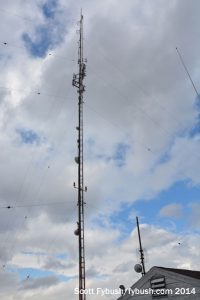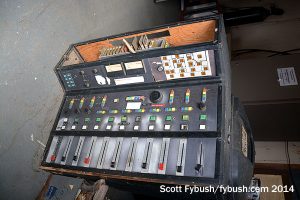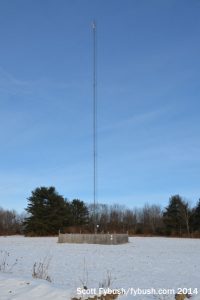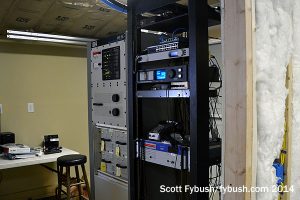NorthEast Radio Watch 12/8/2025: Cichon’s Back in Buffalo
In this week’s issue… Veteran newsman returns - Remembering NY's Leitner, RI's Jones - CT AM saved - Maine AM moves - "Indie" adds suburban signals
Text and photos by SCOTT FYBUSH
In the “now” of 2015, your editor is between a Big Trip to south Florida earlier in March and the annual journey westward to the NAB Show in April. But here in Site of the Week-land, we’re entering 2014 at long last…and doing so close to home, with some wintry visits to a batch of sites in the southern Finger Lakes region.
It’s been just over a year since we ventured down to Ithaca for the dedication of the new “Olbermann-Corneliess Studio” at WVBR (93.5), the commercial station run by Cornell students. In the NorthEast Radio Watch article we wrote about the event, we promised a more extensive look at WVBR’s old and new facilities – and here, at long last, we deliver.
In a history that dates back to the late 1950s on FM, WVBR has been in four studio locations: first in Willard Straight Hall on the Cornell campus, then for many years at 227 Linden Avenue, a prime Collegetown location that was condemned in 2000. After that, WVBR moved to “temporary” digs at a remote location, a small office building at 957 Mitchell Street a few miles north of the campus, too far for car-free students (which is most of them) to walk. While WVBR tried creative ways to make up for that distance, including a trade-out deal with a car service to ferry student DJs back and forth, the “Cow Palace” facility just wasn’t the right spot for the station.
(Why “Cow Palace”? Because while WVBR’s business office and main air studio took up one side of the main floor, the other side belonged to a regional agricultural association; the rest of WVBR was forced down to the basement, where a music office and production studio were down at the bottom of a steep stairway. An unfinished half of the basement was used for storage and, later on, for a very makeshift studio for the freeform CornellRadio.org stream.)
A few years back, the Cornell Radio Guild, newly renamed the Cornell Media Guild, started a capital campaign to get WVBR out of the Cow Palace and back to Collegetown. With some serious help from one of WVBR’s most prominent alumni, Keith Olbermann ’79, the station was able to buy a former campus ministry building at 604 E. Buffalo Street, and after a year of renovations, the new facility was formally dedicated March 15, 2014.
If you come to visit WVBR (and they do welcome visitors!), you’ll enter through the front porch into a big room with a vaulted ceiling that’s now “Studio A,” a space for live music, meetings, storage of WVBR’s extensive vinyl collection – and, on this day, the big crowd that’s gathered for the dedication ceremony. (Olbermann’s here only by phone, recovering from a bad case of shingles, but he still delivers a nice tribute to his late father and to his late classmate and WVBR PD Glenn Corneliess, for whom the new building is named.)
Studio A opens into a back room with several small voice booths for production, as well as into a small office area that connects to the main air studio at the other end of the building. This comfy space is outfitted with a shiny new Axia digital console facing a bay window looking out toward Collegetown; a former closet is now the rack room for the building.

Upstairs, there’s a big lounge area/music library at the top of the stairs on one side; on the other, a former bedroom is now the CornellRadio.org streaming studio, also boasting an Axia console and bright red walls because, well, Go Big Red! (That’s what the FM calls stand for, too – “Voice of the Big Red.”)
At the other end of the lounge area, in another former bedroom, several more prefab voice booths provide additional space for students to produce shows and practice for WVBR airshifts. And it’s all within easy walking distance of campus, readily accessible to Cornell students in a way that the station hadn’t been for a decade and a half.

Few of those students, of course, will ever make the trip to see WVBR’s transmitter on Hungerford Hill, on Cornell-owned farmland a few miles southeast of the main campus. But in the company of WVBR student engineer Kevin Boyle and contract engineer Mark Humphrey, we make the trip up the hill for a peek inside the small white building next to WVBR’s guyed tower.
That’s an Energy-Onix as WVBR’s main transmitter, and tucked next to it near the window an even older General Electric that goes back to WVBR’s earliest days on FM.
There are some WVBR artifacts stored up here, too, including one of the studio consoles from the Linden Avenue studios, one of two homebrewed by WVBR engineer John Allen specifically for the 1973 move from Willard Straight Hall. (An earlier version of this column attributed these consoles to the station’s longtime engineer, the late John B. Hill, but I’m told they actually predate the “JBH” era at the station.)
That light-colored panel on the upper right corner of the console is an intercom system, graphically representing the floor plan at Linden Avenue.
After our WVBR visit, we see another site that Mark’s engineered: W296CP (107.1) is the new FM translator for the market’s ESPN Radio outlet, WPIE (1160 Trumansburg), and it’s one of several translators at a site called City Lights, on the grounds of a bed-and-breakfast by the same name, high up on the hill that overlooks Ithaca from the west.
When we visited in 2014, W296CP was on a pole mounted next to a big empty barn on the east side of the inn, with the translator tucked in a weatherproof enclosure inside. Two other translators, Family Life Ministries’ W205CB (88.9) and what was then ROI Broadcasting’s W242AB (96.3), operated from another barn just south of the inn, atop poles that swayed gently in the winter wind as we watched. The 96.3 translator has since been sold to Saga, the big commercial operator in town, and it’s moving to Saga’s WNYY (1470) site on South Hill, freeing a space for 107.1 to move over to this barn.
(City Lights is also the site of W201CD, the Ithaca Community Radio translator that really serves as the local flagship for the community broadcaster, though it nominally repeats WRFI 91.9 from over in Watkins Glen.)
And we wrap up this week’s installment by heading deeper into the Southern Tier, where we catch up with old friend (and young broadcaster) Dave Radigan at the new home of his WEBO (1330 Owego).
WEBO was nearly dead when Dave bought it a few years back, and he had just started to bring the station back to life when a massive Susquehanna River flood ripped through Owego, forcing the station out of its storefront studio into temporary quarters, first in a trailer at the transmitter site and then up the hill in Dave’s living room.
In 2013, WEBO moved back downtown into new studios across the street from its old home. After another setback – a burst water pipe in an apartment upstairs that again flooded the just-finished studio – things were finally settling down to normal in early 2014 when we stopped in to say hello. The new studio is much nicer than the old one across the street, featuring exposed brick walls and a little less street noise, not to mention spiffy new LCD monitors on the wall above the console.
The corridor that leads from the front vestibule back to the offices at the rear of the WEBO space takes us past the station’s second studio, which serves as a news booth and voicetracking room and in turn looks back into the sales/business office.


Transmitters?
Those have been upgraded, too, since our last visit. The tower that Dave built for WEBO’s AM signal is still there, up on the hill above Route 96 just south of the river across from the center of town – but the small shack he originally built at the AM site has been supplanted by a bigger prefab garage that provides more space for WEBO’s BE transmitter and, in one garage bay, room for a soon-to-be-outfitted emergency studio that will keep the station going if (or when) there’s another big flood or other problem in town.
With Mark Humphrey’s expert help, there are now three FM signals carrying WEBO’s news and music programming to all corners of Tioga County. To the north, WEBO is on 101.3 (W267BQ Richford), and to the west it’s now on 105.1 (W286CS Waverly).
How about WEBO’s original translator on 107.9, W300BV in Owego? It’s upgraded, too, since the day we saw Dave and Mark building it on a temporary site just north of Owego. It’s now a 250-watt signal from Bornt Hill east of Owego, a site that provides nice coverage not only of Owego but also eastward into a decent chunk of the larger Binghamton market.
Thanks to Mark Humphrey, WVBR’s and WEBO’s Dave Radigan for the tours!

As we announced a few weeks ago, the 2026 edition of the Tower Site Calendar will be the last.
We began publishing it 25 years ago, and the broadcast landscape is radically different now.
Radio World just ran an excellent article about us if you want to know more.
Once it’s gone, that’s it. We won’t be printing any more.
Thank you to everyone who saw our announcement and rushed to buy it. We appreciate you.
(There are some calendars from previous years if you want more of a tower photo fix — all under $5.)
But don’t wait to get this year’s Tower Site Calendar — buy it now!
We are selling the Broadcast Historian’s Calendar again this year, but we have that in an even smaller quantity — definitely don’t hesitate for that.
And visit the Fybush Media Store to check out our selection of books and videos, too!
And don’t miss a big batch of Finger Lakes IDs next Wednesday, over at our sister site, TopHour.com!
Next week: New York’s North Country
In this week’s issue… Veteran newsman returns - Remembering NY's Leitner, RI's Jones - CT AM saved - Maine AM moves - "Indie" adds suburban signals
In this week’s issue… Scripps stations face takeover - Sinclair moves more affiliations - CT stations sold - Maine AM surrendered - Remembering WVBR's Shapiro, WABC's Morgan
In this week’s issue… CT TV legend succumbs to cancer - Remembering PA's Adams - FCC still stalled by shutdown - Pittsburgh morning host exits
In this week’s issue… FCC faces reopening challenges - Veteran Boston anchor retires - Morning shift in Toronto - NYC FMs expand reach